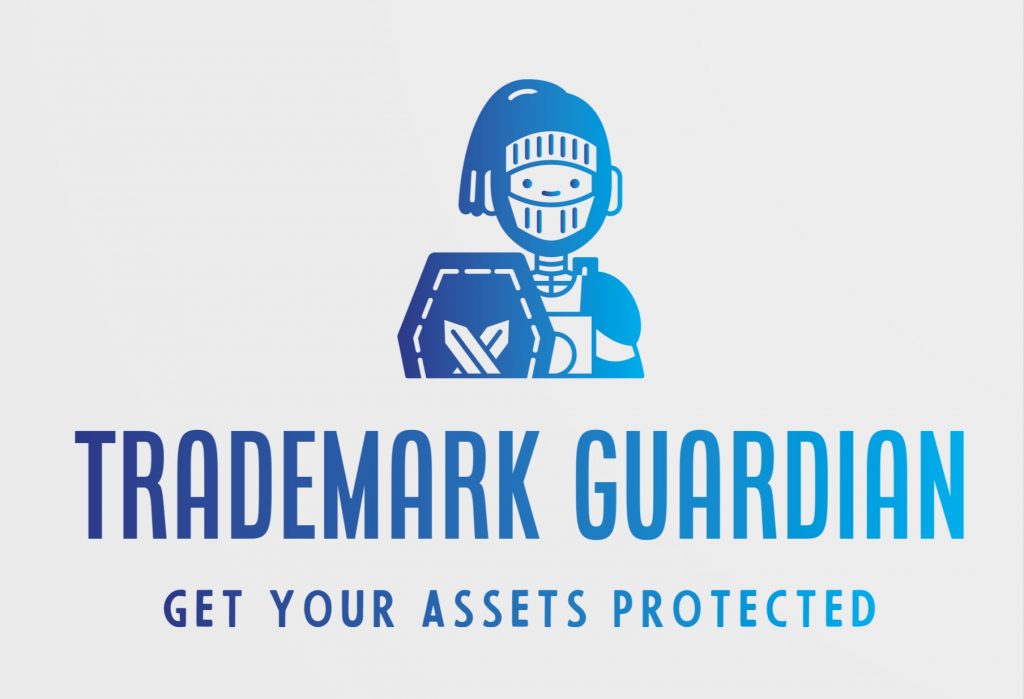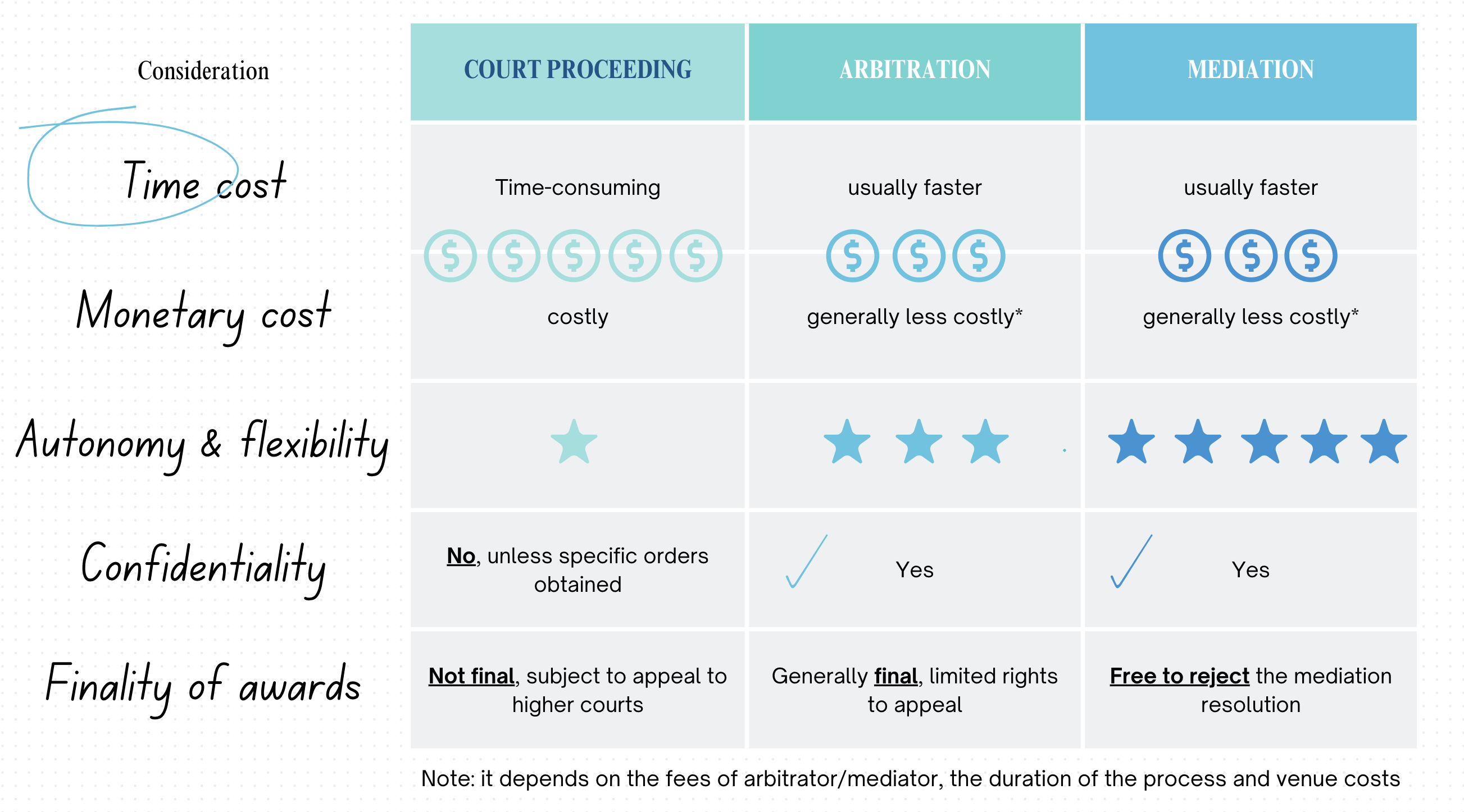
TRADEMARK GUARDIAN
Simple Negotiation
- Start by sending a letter to the infringer, demanding that they stop infringing your trademark.
- Request that they provide a written undertaking not to infringe further. If they agree and sign the undertaking, it becomes a legally binding contract.
Options Overview: Quick guide

Court Proceedings
- If the infringer doesn’t respond positively or continues infringing, you may need to go to court to enforce your rights.
Consult lawyers to gather enough evidence to prove the infringement and help you begin the legal action by filing a Writ, which includes a formal statement of your claim against the defendant and the grounds supporting your claim.
- Statutory ground under s.18(2) & (3) of Trade Marks Ordinance: A person infringes a registered trade mark if—
- (a) he uses in the course of trade or business a sign which is identical/similar to the trade mark in relation to goods or services which are identical or similar to those for which it is registered; and
- (b) the use of the sign in relation to those goods or services is likely to cause confusion on the part of the public.
- After serving the writ, the defendant has 14 days to indicate whether they intend to oppose your claim.
- If the defendant doesn’t respond, you can obtain a default judgment. If they defend, the case proceeds to trial.
- Present your evidence in court, and the defendant will present their defense.
Awards/Remedies
If successful, the court may grant any any of the following orders:
(1) Injunction:
This is an order requiring the infringer to cease infringing your IP.
(2) Damages:
This is an order requiring the infringer to make financial compensation to you for the infringing conduct that occurred.
(3) Account of profits:
This is an order requiring the infringer to pay you all the profits that it earned as a result of the infringing conduct. Depending on the case, the amount of profits accounted for may be greater than the damages that have been awarded by the court.

Arbitration
- Arbitration is an alternative dispute resolution method outside of the traditional court system.
- It was clearly recognised in the Arbitration (Amendment) Ordinance (Cap. 609), which came into effect on 1 Jan 2018, disputes over IP rights can be resolved through Arbitration in Hong Kong.
- In this process, the parties involved agree to appoint a neutral third party, known as an arbitrator, who hears arguments on both sides and makes a binding decision.
- The parties mutually agree to resolve their dispute through arbitration instead of going to court. They would enter into arbitration agreement.
The parties must reach a consensus on whom to appoint as an arbitrator. Although it is possible to appoint anyone as arbitrator, it is generally preferred to select a person with experience in the field of IP law and as an arbitrator.
- Suggestions on how to find an arbitrator: https://www.hkiac.org/arbitration/arbitrators
- Arbitrator controls procedures unless rules agreed in arbitration agreement. Parties are encouraged to adopt the HKIAC Domestic Arbitration Rules or the HKIAC Administered Arbitration Rules.
- Hearings can take place anywhere convenient like arbitrator/lawyer offices. The HKIAC (at 38/F, Two Exchange Square, 8 Connaught Place, Hong Kong) also provides good facilities for arbitration hearings at reasonable charges.
- Each party presents their arguments and evidence to the arbitrator, who carefully listens and considers both sides.
- It is also possible for the parties to agree to have a “documents-only arbitration” i.e. without a hearing.
- Based on the presented arguments and evidence, the arbitrator makes a decision that is legally binding on both parties.
- Arbitrator decides allocation of costs and arbitrator fees (which usually hourly around HK$5,000-6,000), usually to losing party.
- Limited rights of appeal depending on arbitration agreement.
Key Benefits of Arbitration:
Meditation
Mediation is an alternative dispute resolution process where a neutral third party, named as mediator, facilitates negotiation between disputing parties.
The goal is to foster communication, promote understanding and assist the parties to reach a common ground and voluntary agreement.
The parties mutually agree to resolve their dispute through meditation instead of going to court.
The parties must reach a consensus on whom to appoint as a meditator. There is no strict requirement of who can be a mediator, but IP lawyers or mediation organizations are ideal mediators.
Suggestions on how to find an meditator: https://mediation.judiciary.hk/tc/ https://www.jointmediationhelpline.org.hk/
- The mediator will arrange a meeting for both sides to present their case.
- The mediator does not make decisions, but helps facilitate constructive discussion and reaching of consensus.
- It is possible that no common ground can be reached, the parties may resort to court proceedings.
- If successful, both sides sign a legally binding agreement on the negotiated terms.
Benefits
Limitations
(1) Fast and cost-effective:
Quicker and less expensive compared to going to court
(2) Preserves relationships:
Finding a win-win solution rather than a winner and a loser
(3) Confidentiality: Mediation sessions are private and confidential
(1) Non-binding outcome: If an agreement is not reached, the parties may still need to pursue other legal avenues to resolve their dispute.
(2) Unsuitable for Complex Legal Issues which require legal interpretation
Reporting to the Customs
- If infringing goods are imported into Hong Kong SAR, you can make a complaint to Customs and Exercise Department (C&E), leading to the seizure or detention of the goods.
- To make a complaint, you need to find an expert who can
(i) identify counterfeit goods and
(ii) is willing to testify if needed.
Trademark owner makes a complaint to C&E
According to the requirements.
C&E detains the goods
After the detention, trademark owner is given a final opportunity to inspect the goods.
Charges against the infringer
If the goods are confirmed to be counterfeit or infringing, C&E seizes the goods and presses charges against the infringer.
Counterfeit or infringing goods destroyed
If the prosecution is successful, the court orders the counterfeit or infringing goods to be destroyed.
Issue of Unregistered Trademark
Questions: What if the trademarks are unregistered in the first place, have the owners lost all their rights or actions against the infringers?
- Answer: No, unregistered trademarks can be protected by the common law action of passing off. It requires prove of
- Goodwill or reputation in the unregistered trademark and
- The other party misrepresented their goods or services under your unregistered trademark.
(s. 12(5)(a) of the Trade Marks Ordinance)
This action is more difficult to bring than the action of infringement of a registered trademark. However, you may still have a winning case.
(See below an example of how an unregistered trade mark owner may subsequently register its mark despite an existing identical or similar trade mark registration.)
Case Illustration
Takeaways:
You can still protect your trademarks if you can prove
(1) Your reputation and
(2) the registered mark’s use may cause confusion.
Remember to consult with a trademark lawyer to understand your rights and explore possible solutions, such as legal actions and other dispute resolution methods.
Useful Links
Disclaimer: Nothing in this website is intended to be nor should be construed as legal advice. This is an educational project created by students. Please consult your lawyer for legal advice.